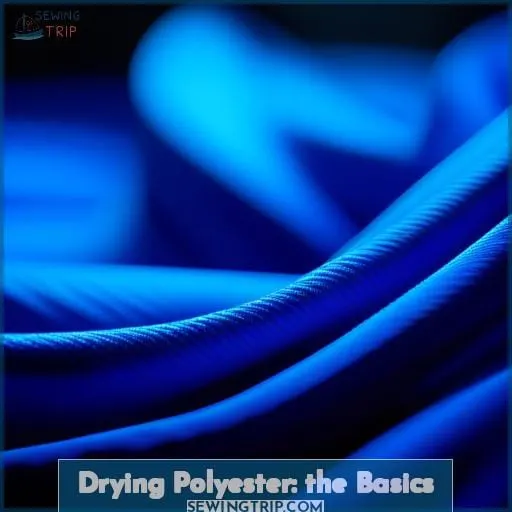This site is supported by our readers. We may earn a commission, at no cost to you, if you purchase through links.

From understanding the synthetic nature of polyester to mastering the art of drying without damage, we’ll explore how temperature settings impact the integrity of your garments. Polyester’s resilience to heat sets it apart, yet caution is paramount to avoid any potential mishaps.
Embrace these best practices for drying polyester garments, ensuring they emerge from the dryer in pristine condition, ready to wear with confidence and peace of mind.
Table Of Contents
Key Takeaways
- Polyester is a durable fabric that can generally be put in the dryer, but it should be dried on a low heat setting to prevent damage such as shrinkage, color loss, and static cling.
- Using dryer sheets or wool dryer balls can help reduce static cling and wrinkles when drying polyester garments.
- It is advisable to avoid using fabric softener with polyester as it can affect the fabric’s moisture-wicking properties.
- While high-quality polyester resists shrinkage better, drying polyester still contributes to microplastic pollution and resource consumption.
Understanding Polyester Fabric
Understanding Polyester Fabric
Diving into the world of polyester, you’re not just exploring a fabric; you’re embarking on a journey through history, innovation, and the quest for durability. Born out of necessity during World War II, polyester has evolved from its initial role in parachutes to becoming a staple in our wardrobes and homes.
Its creation, a testament to human ingenuity, involves transforming ethylene—a petroleum byproduct—into a fiber that’s both versatile and enduring.
Polyester’s superpowers include an impressive resistance to wear and tear, making it the superhero of fabrics. Whether you’re scaling a mountain or just trying to get through a day at the office without spilling coffee on yourself, polyester’s durability has got your back.
But it’s not all about being tough; this fabric knows how to keep its cool, literally. Thanks to its moisture-wicking abilities, it keeps you dry and comfortable, whether you’re running a marathon or running late.
And let’s talk about its elasticity. Polyester doesn’t just stretch; it bounces back, ensuring your clothes maintain their shape and don’t sag after a long day. This resilience makes it a favorite for everything from your favorite stretchy yoga pants to form-fitting tops.
But it’s not just about what polyester can do for you today. The fabric’s journey towards sustainability is on the rise, with advances in polyester recycling paving the way for a future where fashion and environmental responsibility go hand in hand.
So, as you zip up that polyester jacket, remember, you’re wearing a piece of history, innovation, and the promise of a more sustainable future.
Drying Polyester: the Basics
When it comes to drying polyester, you’re playing a game of temperature chess. You want to checkmate moisture without scorching your beloved garments. Polyester, a fabric that’s as common in wardrobes as misplaced socks, has its quirks when facing the heat of the dryer.
First off, let’s talk moisture absorption. Polyester isn’t a thirsty fabric; it doesn’t guzzle water like cotton does. This means your drying time is on the fast track, a boon for those of us who can’t wait to slip back into our favorite shirt.
But here’s where it gets tricky: fabric texture and heat are frenemies. Too much heat, and you risk turning your sleek polyester garment into a wrinkle fest or, worse, a shrinkage sob story. And let’s not forget static buildup – the unwanted guest that clings to polyester like bees to honey, making your clothes more electric than a rock concert.
So, what’s the secret sauce for drying polyester? It’s all about moderation. Think of your dryer’s heat setting as a dial on a toaster. You want your bread golden, not charcoal. A medium or low heat setting is your go-to, ensuring the integrity of the fabric’s texture while warding off static and wrinkles.
Remember, when it comes to drying polyester, patience is a virtue that pays off in spades, or in this case, in perfectly dried clothes.
Temperature Settings and Their Effects
When it comes to drying polyester, you’re playing with fire if you crank up the heat too high—literally. Polyester is like that one friend who can’t handle their spice; turn up the heat, and things can go south quickly.
So, keep it cool, or at least moderate, to avoid a meltdown. A medium heat setting is your polyester’s happy place, striking a balance between drying time and garment care.
Think of it as a spa day for your clothes: the right temperature soothes the fibers, preventing them from wrinkling up like a prune or sparking up static cling like a bad hair day. Plus, it’s a win-win for your wallet and the planet, as lower temperatures mean energy efficiency and less wear and tear on your beloved threads.
The Impact of Heat on Polyester Fibers
When you’re drying your polyester clothes, it’s like walking a tightrope over a pit of fabric damage. Too much heat and you’ll witness the horror of shrinkage, color loss, and the dreaded static cling.
Imagine pulling your favorite shirt out of the dryer only to find it’s morphed into a size fit for a teddy bear—yikes! But it’s not just about size; excessive heat can make your polyester garments wrinkle up like a prune or lose their vibrant color, turning your bright reds into washed-out pinks.
Polyester fibers are like ice cream in the sun; they just can’t handle the heat. Crank up the temperature too high, and they’ll melt away, leaving you with fabric that’s as rigid as a board. So, what’s the secret sauce for keeping your polyesters pristine? Stick to low heat, and you’ll avoid turning your clothes into a science experiment gone wrong.
Remember, when it comes to polyester, it’s better to be cool than to have a meltdown.
Best Practices for Drying Polyester Garments
When it comes to drying your polyester garments, think of yourself as a bit of a fabric whisperer, guiding them gently to their optimal dryness without causing a scene (like shrinkage or static cling).
First off, ditch the high heat; it’s the archenemy of polyester, capable of turning your beloved items into something that wouldn’t even fit a teddy bear. Opt for a low heat or air dry setting on your dryer. This is like giving your polyester a cozy, warm hug without the squeeze.
Now, let’s talk about the dreaded static cling and wrinkle formation. Ever pulled a shirt out of the dryer only to find it’s clinging to you more desperately than a koala to a tree? Here’s where dryer sheets or wool dryer balls come into play.
They’re like the peacekeepers in the dryer, reducing static and keeping your clothes from tangling up into a wrinkled mess. If you’re using dryer sheets, remember they’re also your secret weapon against fabric softener, which can be a no-go for polyester, as it can affect the fabric’s moisture-wicking properties and lead to buildup.
Be mindful of dye transfer, especially if you’re drying lighter colored fabrics with darker ones. It’s like inviting a bull into a china shop and hoping nothing breaks. Separate your colors to keep everything looking as it should.
Lastly, keep an eye on the drying time. Polyester doesn’t like to lounge around damp for too long, but it also hates being blasted with too much heat. Finding that sweet spot in drying time ensures your garments come out ready to wear, without the extra chore of ironing out wrinkles or dealing with static cling.
Remember, it’s all about giving your polyester the gentle, loving care it needs to stay in tip-top shape.
Frequently Asked Questions (FAQs)
How can I remove a burnt plastic smell from polyester clothes after drying?
To banish that burnt plastic stench from your polyester threads, give ’em a whirl in the washer with a cup of white vinegar plus your usual detergent.
Air dry afterwards—heat’s the enemy here!
Repeat if needed.
Are there any specific detergents recommended for washing polyester to prevent damage during drying?
Polyester, a resilient synthetic fabric, doesn’t require specialty detergents; any regular brand will do the trick.
Keep your threads in top shape by avoiding high heat and opting for a gentle cycle.
Can adding certain items to the dryer with polyester garments help reduce static cling and if so, what are they?
Tossing wool dryer balls into the dryer with your polyester threads can work wonders for nixing that pesky static cling. These little heroes bounce around, creating air pockets that prevent clothes from rubbing together.
Plus, they’re a green alternative to single-use dryer sheets. So, not only do you get to say goodbye to static, but you’re also doing Mother Earth a solid.
Talk about a win-win!
How does the construction and quality of a polyester garment affect its behavior in the dryer, particularly regarding shrinkage and static?
The quality and construction of polyester garments significantly influence their behavior in the dryer.
High-quality polyester resists shrinkage better, but poor construction may lead to deformation.
To dodge shrinkage and static, keep it cool and don’t overstay in the heat’s embrace.
What are the environmental impacts of drying polyester garments, considering their petrochemical origins?
Drying polyester garments weaves a complex tapestry of environmental impacts, rooted in their petrochemical origins.
These synthetic fibers, while convenient, are a double-edged sword. On one hand, they offer durability and versatility; on the other, they contribute to the proliferation of microplastics and demand a significant toll on our planet’s finite resources.
As these garments dance in the dryer, they shed microplastics, tiny but tenacious pollutants that journey through waterways into the ocean, eventually entering the food chain.
This invisible fallout from our laundry routines underscores a broader narrative of sustainability and consumer responsibility. It’s a stark reminder that the choices we make in our closets ripple across ecosystems, urging a shift towards more sustainable practices and materials.
Conclusion
Navigating the waters of laundry care, especially when it comes to synthetic fabrics like polyester, can feel like walking a tightrope.
But fear not, as you’ve been armed with the knowledge to dry your polyester garments without turning them into a cautionary tale. Remember, while polyester is more forgiving than some fabrics when it comes to heat, treating it like a delicate flower rather than a weed will ensure it doesn’t wilt under pressure.
By adhering to the recommended temperature settings and embracing the best practices outlined, you can confidently put polyester in the dryer, knowing your clothes will come out looking as good as they went in.
This isn’t just about drying clothes; it’s about preserving the life and integrity of your wardrobe essentials.











